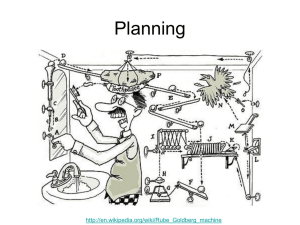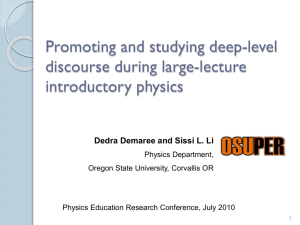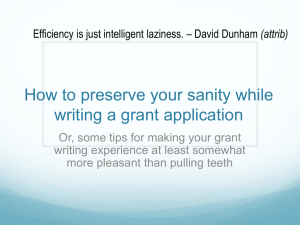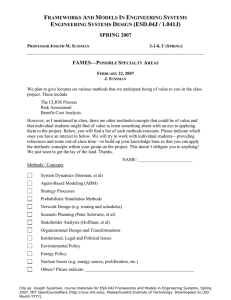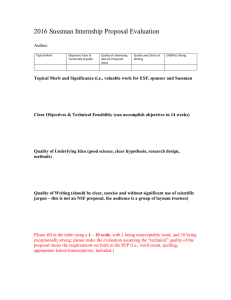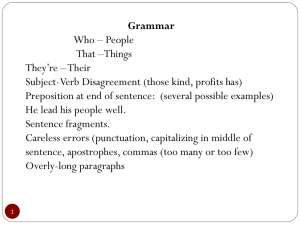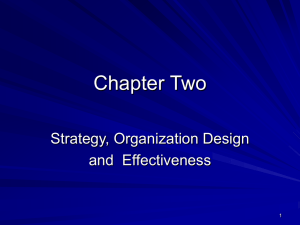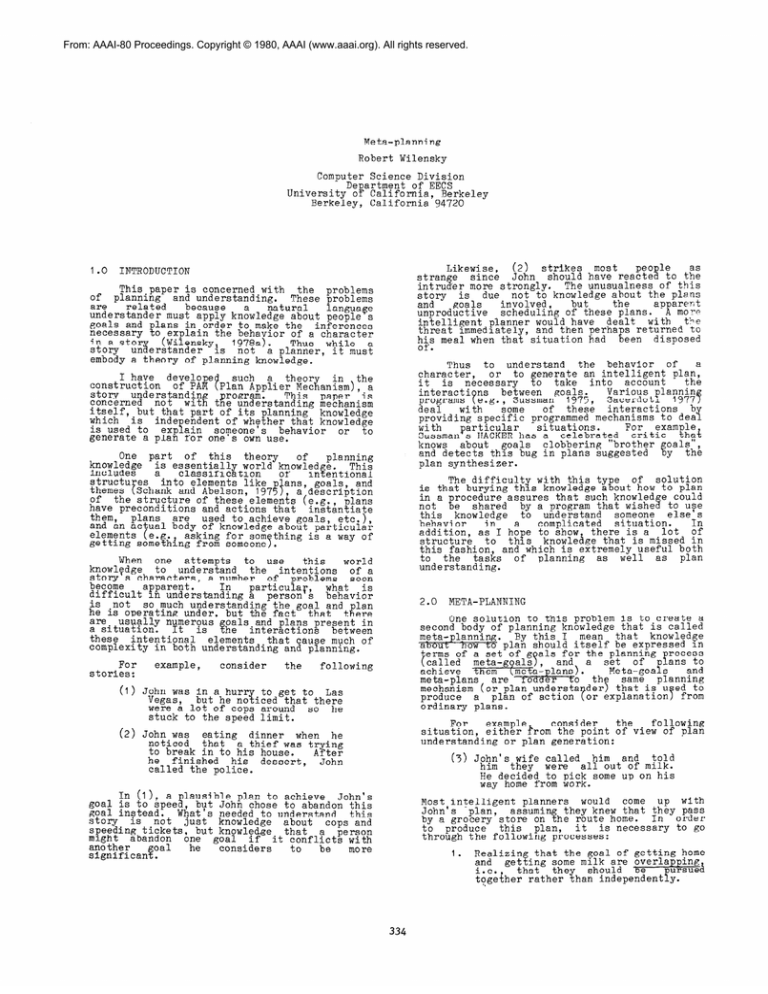
From: AAAI-80 Proceedings. Copyright © 1980, AAAI (www.aaai.org). All rights reserved.
Meta-planning
Robert Wilensky
Computer Science Division
De artment of EECS
University oF California, Berkeley
Berkeley, California 94720
1.0
strikes most
Likewise, (2)
strange since John should have rea%",z'Fo t:z
intruder more strongly. The unusualness of this
;;;ry is due not to kno;r;dge ;,";utthe plans
ap arent
involved,
goals
unproductive scheduling of these plans. 1 more
intelligent planner would have dealt with t?e
threat immediately, and then perhaps returned to
;+s meal when that situation had been disposed
.
INTRODUCTION
This paper is concerned with the problems
of planning and understanding. These problems
are
related
because
natural
language
understander must apply knEwledge about people s
goals and lans in order to make the inferences
necessary fo explain the behavior of a character
in a sto
u~er~~~~;;;ky, 19,;3Fa). Thus while
story
a planner, it mus?
embody a theory of plilning knowledge.
Thus to understand the behavior of
character, or to enerate an intelligent plana
th;!
take into account
it is necessary f0
interacti ns between goals.
y;;;py;+f;g
programs.9e.g., Sussman 1975,
interactions bv
deal
providi&tkpec??-!E pr~&a~~%emechanisms to deal
situations.
with
particular
Sussman s HACKER has a celebrated FZL tZ""~iEt
knows about goals clobbering "brother oalslt,
and detects this bug in plans suggested $Y the
plan synthesizer.
I have dt?;e+;get
construction
PIZYhApp?ieZh$Z rl
anliZm>
*
F":
story understanding rogram.
This paper is
concerned not with tR e understanding mechanism
itself, but that part of its lanning knowledge
which is inde endent of wheif
her that knowledge
is used to
21 *
someone's behavior or to
generate a p%
"f,'",
one's own use.
One part of this theory
of
plan;;i;fg
knowledge is essentially world knowled e.
includes
a
classification of
infentional
The difficulty with this ty e of solution
is that burying this knowledge at out how to plan
in a rocedure assures that such knowled et;o;zi
not %e shared by a program that wishe2
this knowledge to understand someone else's
complicated situation.
behavior
in
a
addition, as I hope to show there is a lot i"f
structure to this knowle6ge that is missed in
this fashion, and which is extreme~l.l~sefulboth
as plan
to the tasks of planning as
understanding.
them, plans are used to achieve goals, etc.)
and an actual body of knowledge about particula;
elements (e'f'2 asking for som thing is a way of
getting some hing from someone7 .
When one attempts to use
this
world
knowledge to understand the intentions of a
story's characters, a number of problems soon
become
apparent.
particular, what '
difficult in understan%ng a person s behavii:
so much understanding the goal and
iz iE':perating under, but the fact that t#$%
are usually numerous oals and plans present in
a situation. It is fhe interactions between
these intentional elements that cause much of
complexity in both understanding and planning.
For
stories:
example,
consider
the
2.0
META-PLANNING
One solution to this problem is to create a
second body of planning knowledge that is called
meta-planning. By this I mean that knowledge
about now to plan should itself be expressed in
;;ys,;f a set of g alsaf,;rthesg;an;pg recess
E
meta-goals'5,
P
achieve th e~re~m~~Z1~n~~.atheMe~~~~oa~~~~~~~~
meta-plans
mechanism (or plan understa der) that is u ed to
or explanation7 from
produce a plan of action if
ordinary plans.
following
(1) John was in a hurr to get to Las
Vegas, but he noI*
iced that there
were a lot of cops around so he
stuck to the speed limit.
following
the
For
example
consider
situation, either Prom the point of view of plan
understanding or plan generation:
(2) John was eating dinner when he
noticed that a thief was ti$;;f
to break in to his house.
he finished his dessert, John
called the police.
(7) John's wife called him and told
him they were all out of milk.
He decided to pick some up on his
way home from work.
Most intelligent planners would come up with
they knew that they pass
John's -plan, assumi
by a grocery store onT he ;;ute home. In order
is necessary to go
to produce this plan,
through the following processes:
1.
334
2.
2.1
A&j;sting one's plans according1
case, the plan is modifie3' so Ia:
to
Produce a route that takes the
planner near the grocery store.
2.
The "go home" plan is suspended at
the point at which the grocery
store is reached.
3.
The "get milk" plan is executed.
4.
The "go home" plan is resumed.
Kinds Of Meta-goals
The following is a brief description of the
more important meta-goals so far encountered,
along with the situations in which the
arise
and some standard plans applicable I o them.
This list is not meant to be cornlete.
merely
reflects
the current sta?e of 0::
analysis.
META-GOALS, SITUATIONS, AND META-PLANS
1.
Don't Waste Resources
Situations to Detect
1.
In terms.of meta-planning, this situation
an
has
the ;f;;o;;;
structure: There '
d "Don't Waste Resou*Ees".
imnortant
Goal Overlap
Associated meta-plans:
1.
2.
meta-pian fulfills the 'Don't Waste Resources"
meta-goal.
Schedule Common Subgoals First
2.
Plan Integration
'a
Plan Piggybacking (find a new
g~~nflalls
k",;kgoa~;~ultaneously
Multiple
Planning Options
(more
plan is applicable to a
l%tin g:l)
Associated meta-plans:
1.
The advantage of the meta- lanning approach
eal with complex
is that the problem of how to Ei
goal interactions can be stated as a problem to
be solved ,,by the same planning mechanism one
applies to ordinary" goals. For example, one
may first try out a number of canned sol;;;ons,
lf
then some standard planning procedures,
all
else fails, try to construct a novel
solution.
3.
Select Less Costly Plan
Plan Non-integrability situations
in which the execution o two plahs
will adversely affect one another
undoes
subgoal
one
e.5,
established by the otherB
Associated meta-plans:
Note that there are
at
least
three
important differences between meta-plannin and
+
planning
using
constraints
Constraints and plan generators Ze asGike:ZE
in that constraints reject plans, but they don't
In constrast
themselves propose new ones.
meta-goals not only pick up violations, but
plans
to
fix
the problem.
su gest
new
Me fa-goals are declarative structures, and thus
may be used in the ex lanation process as well
In a3dition, meta-goals are
as in planning.
independent, encoding only knowledge
domain
about planning in general.
1.
4.
Schedule Sequentially
Recurring Goals
repeatedly)
(A
goal
arises
Associated meta-plans:
1.
McDermott's notion of a
secondary task comes closest to
*AotP,'n
0;
meta-planning I propose here.
A policy is
essentially
ex licitly
r;epeEezz;ted
ifferences
constraint. Theli;;rnaryx*
polic
and a
- oal are that meta-goal:
tha'i are
not
necessarily
inclu3e
goals
constraints
meta-goals refer CXI;T,;~
facts about pE,"~ni~~'as their domain,
include
domain
specific
policies
may
information; policies often entail the creation
psuedo-tasks, whereas
meta-goals
have
of
meta-plans that deviate less from the structure
of normal plans.
-5.
ubsume Recurring Goal
that
state
fulfills a re:ondition for a
plan for rhe goal and which
ndures over a
of time
7see Wilensky, P%~
9Establish
Recursive subgoals (a subgoal is
identical to a higher level goa ,
causing a potential infinite loop$
Associated meta-plans:
1.
2.
Select Alternate Plan
Achieve As Many Goals As Possible
Situations to detect
Hayes-Roth and Hayes-Roth (1978)
uses the
term meta-nlannina to refer to decisions about
the planning process. While my use of the term
similar to theirs the include all types of
cyanning decisions under tK is name, and their
meta-planning is not formulated in terms of
explicit meta- oals and meta-plans. I use the
re5er only to a subset of this
term
to
and only when that knowledge is
knowledge
conveniently expressable in terms of explicit
meta-goals and meta-plans.
1.
Goal Conflict
Associated meta-plans:
various conflict resolution plans
(see Wilensky 1978a)
2.
335
Ass mme;;$;otGoal Conflict
(Both
be accomplished‘if A
goa3[
s
erformed beff;;;B, but B being
kgrFormed
poses
no
difficulty)
Ef a stored lan for this oal is to wear
rotective clotRing, it woufd be scheduled
% efore the initial plan. If not, then we could
establish a subgoal of getting a raincoat. This
mia:; spawn a plan that involves going outside,
would violate the Recursive Subgoals
to choose
condition. The ~;ta--~la;ai~e;; *
lan.
t?nd one, the
another
"Achieve x:
s Many Subgoals As Possible" meta-goal
is activated, as a goal conflict is now seen to
exist. The meta-plans for goal conflict resolution are attempted.
If they fail, then an
unresolvable goal conflict situation exists, and
Maximize the Goals Achieved is activated. The
meta-plan here is to abandon the less important
goal. The nlanner selects whichever goal he
values more and then abandons the other.
Associated meta-plans:
Schedule Innocuous Plan First
2.
3.
Plan Splicing (If one plan has
already been started, suspend
it divert to the other plan,
6
original plan when
ie"wp%?%s
been executed)
Goal Competition (Goal interference
with the goal of another planner)
Associated meta-plans:
1.
2.
3.
various anti-plans (plans to
deal specificly with
opposition)
3 .O
various plans for resolving the
competition
Maximize
Achieved
the Value
of
the
use
We are
currently attemptin
meta-planning in two programs. FAM,? sto
understanding
uses kno;;EtfEsabout w Y
involving
interactions ?$StE:derstand
goalS.
As PAM has been discussed
:Ytple
length elsewhere, we will forego a discussion of rts use of meta-planning here.
Goals
Meta- lanning is also being used in the
developmenP of a planning program called PANDORA
(Plan ANalyzer
with
D namic
Organization,
Revision and Applicationai. PANDORA is given a
d,,esrcrit
;io;ozfsa $tuation and. creates. a plan
may have in that situation.
R
PANDORA
.
dynamically told
about
new
developmen$z, and changes it plans accordingly.
Situations to detect
1.
Unresolvable Goal Conflict
Associated meta-plans:
1.
4.
APPLICATIONS
Abandon Less Important Goal
Don't Violate Desireable States
Situations to detect
1.
Danger
Associated meta-plans:
1.
2.
Create a preservation goal
Maintenance Time
Associated meta-plans:
1.
3.
Perform Maintenance
References
Anticipated Preservation Goal
performance of another plan $??
cause the plann r
to
have
a
preservation goale
Associated meta-plans:
1.
Select Alternate Plan
2.
Protective Modification (Modify
original plan so as n t to
provoke preservation goalP
11
Hayes-Roth, B. and Hayes-Roth, F. (1978).
Cognitive Processes in Planning. RAND
Report R-2366-ONR.
21
McDermott, Drew (1?78>. PLanning and
$cting. In Cognitive Science vol. 2, no.
.
31
Sacerdoti, E. D. (1977). A Structure for
Plans and Behavior. ElZevier
North-H?iIlanu,Amsterdam.
41
Schank, R. C. and Abelson, R. P.
%%%%in~?@~'L%%&e%$lbaum
Billsdale, N.J.
51
61
336
(1977).
Press,
Sussman G. J. (1975). A Cornuter Model of
$%:l~o~;quisition. Aiiie?&&ETs~,Wilensky R. (1978). Understanding
goal-based stories. Yale University
Research Report #140.

